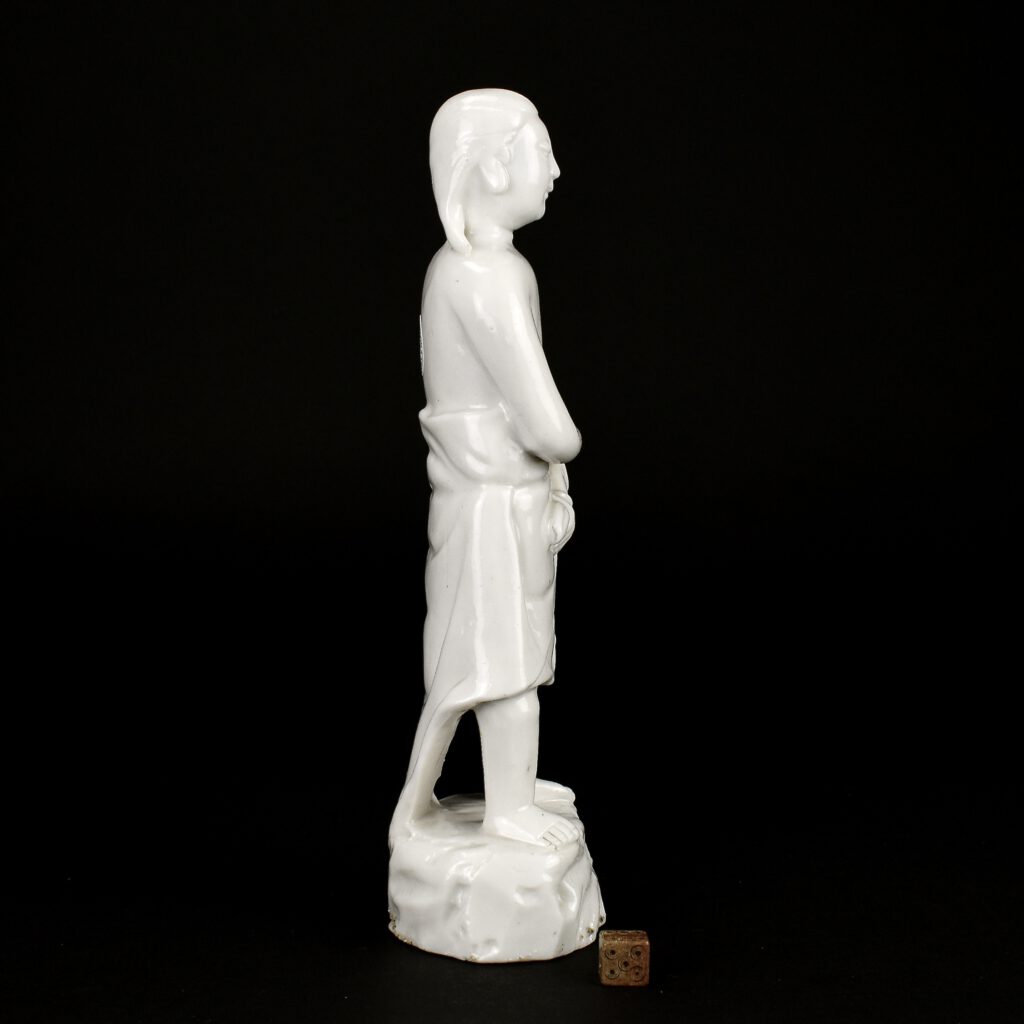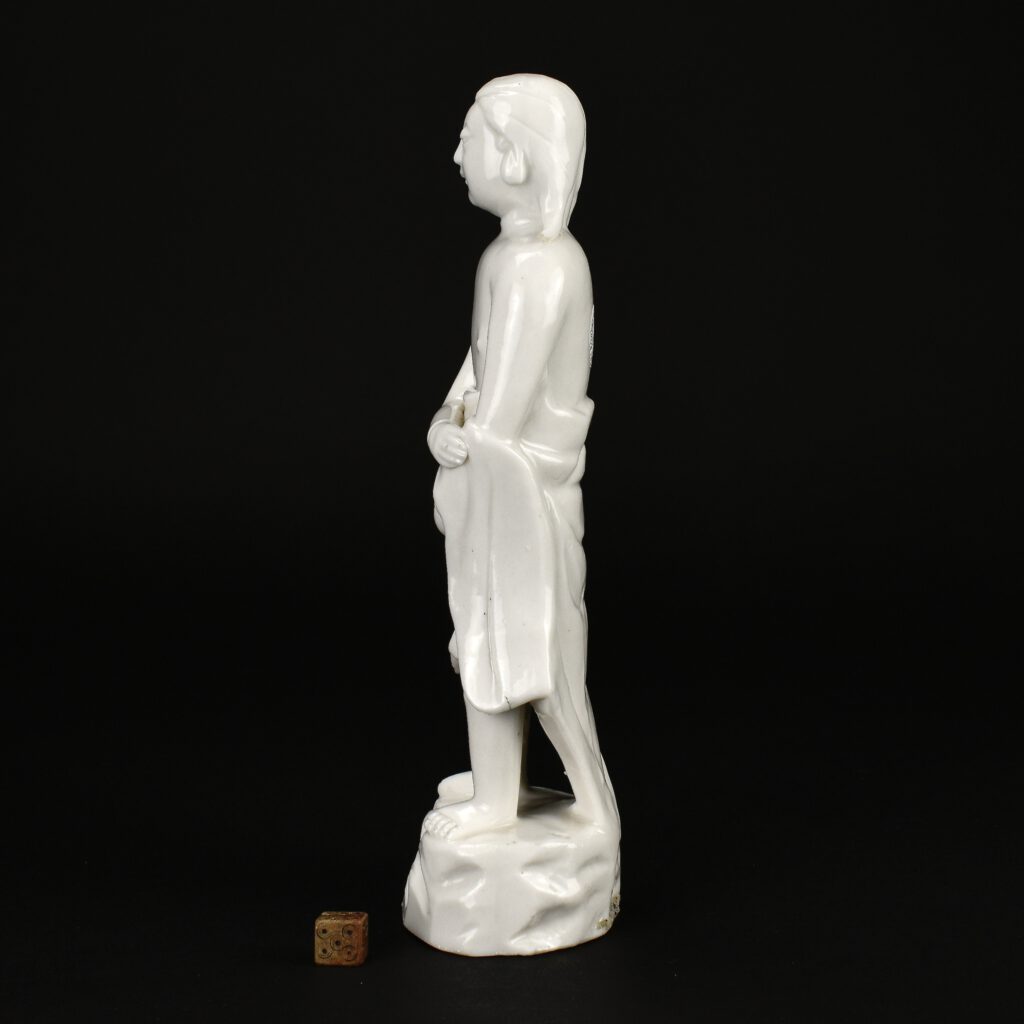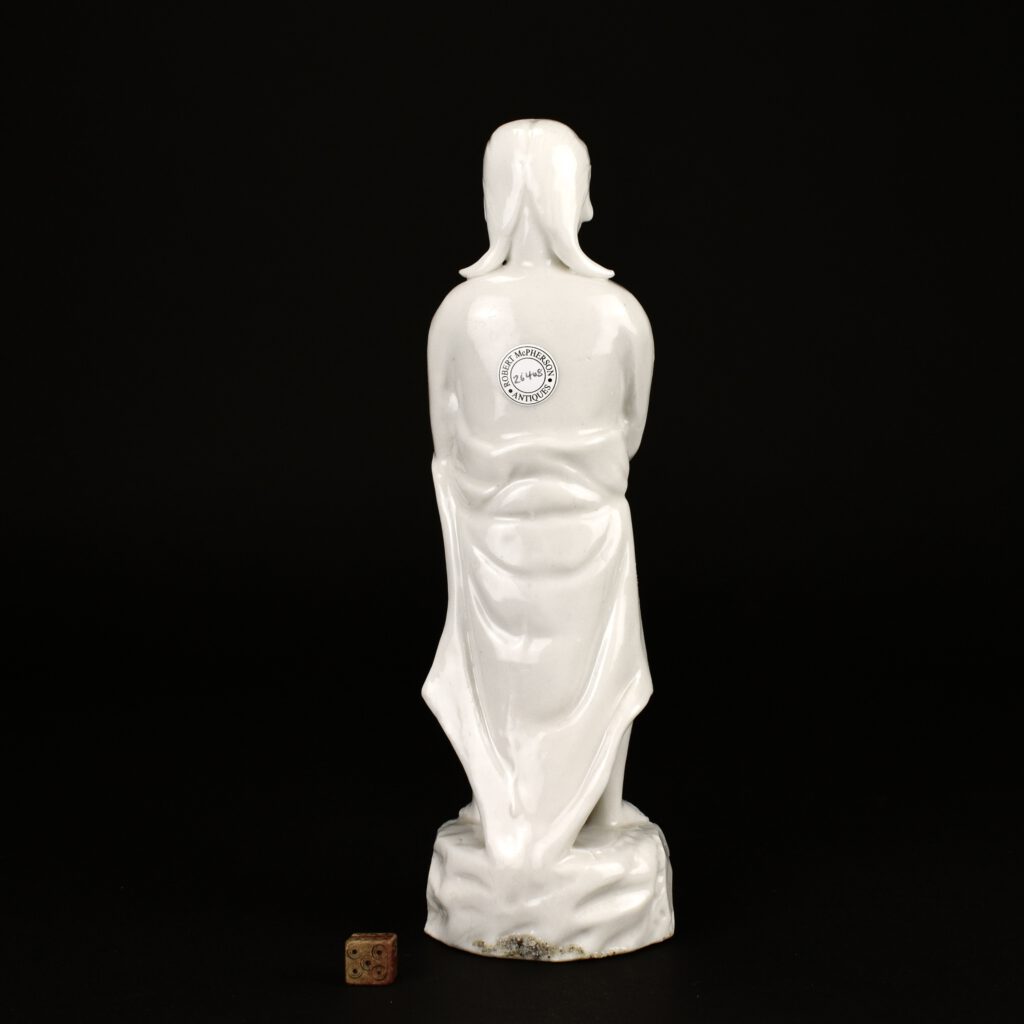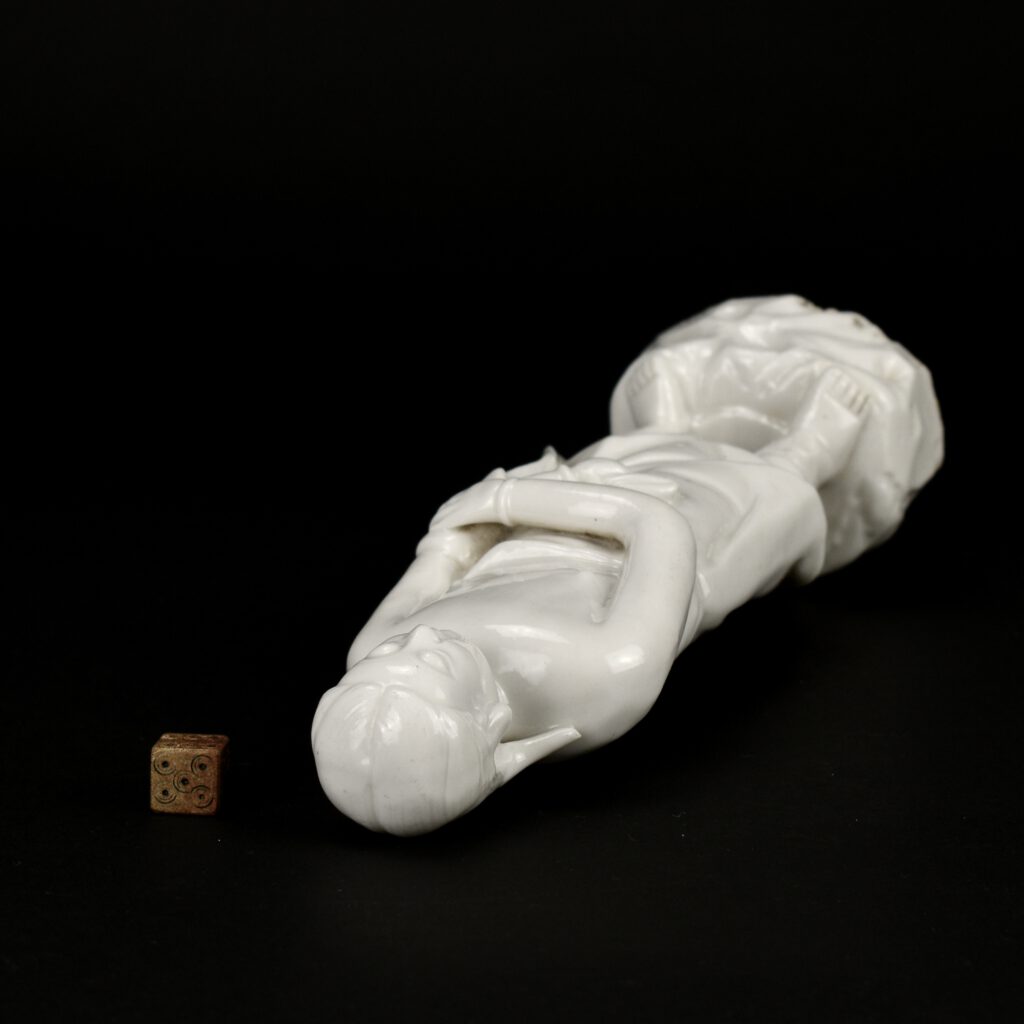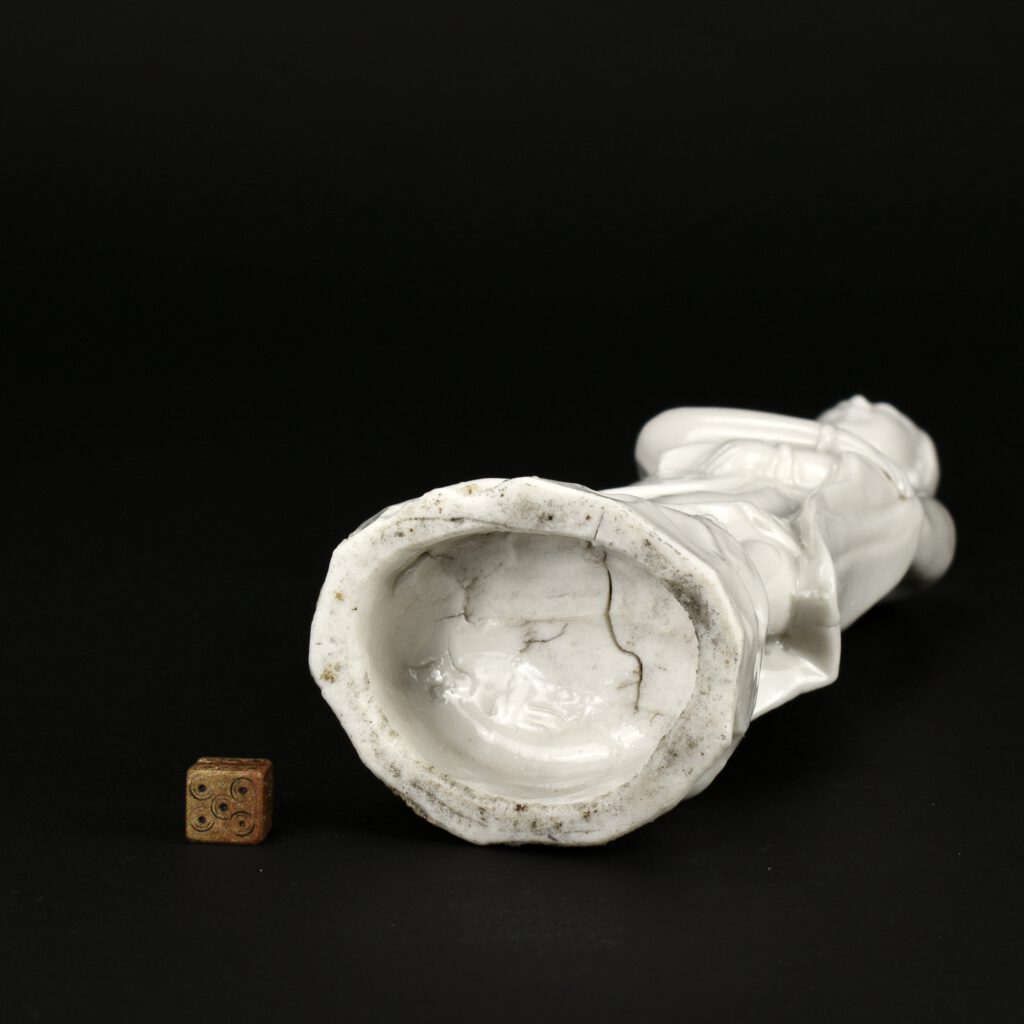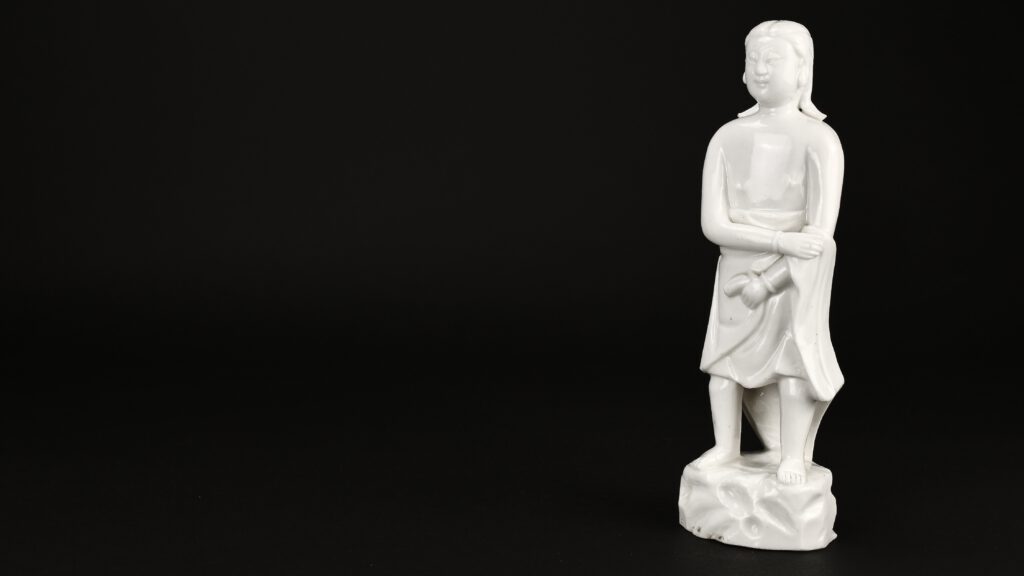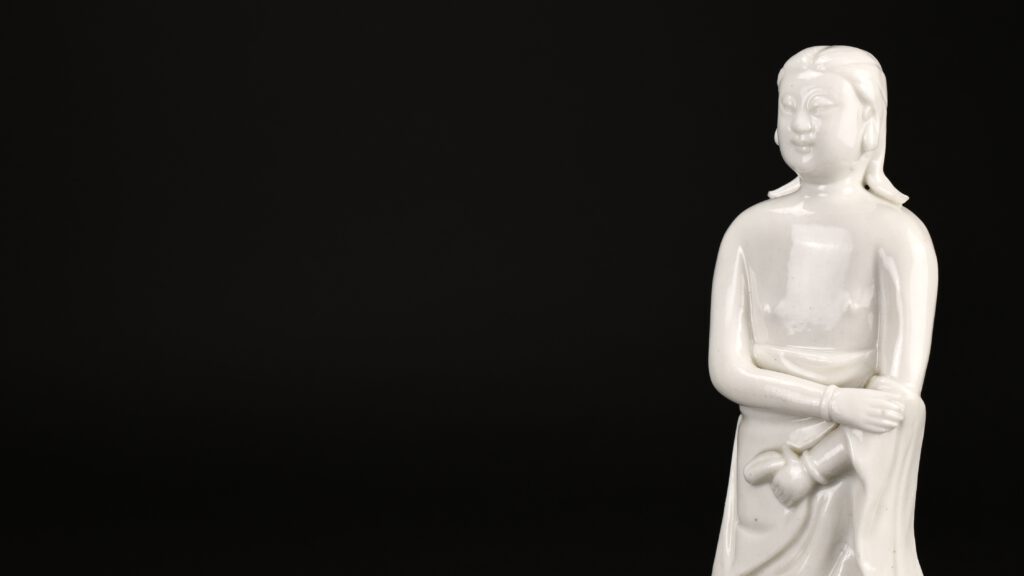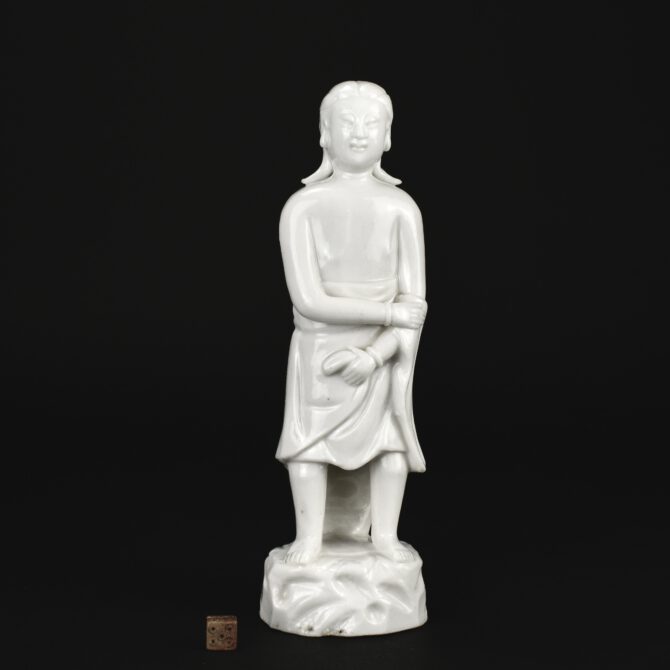
Blanc de Chine Porcelain Model of ‘Adam’
A Blanc de Chine Porcelain Model of a Man, sometimes referred to as `Adam`, Dehua Kilns, Fujian Province, Kangxi Period c.1690-1710. The Chinese man with his neatly divided and tied hair stands on a simple oval rusticated mound with nothing more than a cloth around his waist which he appears to be holding onto. A group of Blanc de chine porcelain models of of standing semi-naked figures on oval rusticated bases have traditionally been referred to as Adam and Eve. This is possibly because their clothing is so scant and simple they can be seen as having a passing resemblance to images of Adam and Eve in Western art. But as David Freedman points out in S.Marchant & Son`s 1985 catalogue of an exhibition of blanc de chine “.. there is no doubt that the face and hair-style are Chinese and there is nothing to suggest a European model”. European models were used as prototypes for blanc de chine figures but they always have something to betray their Western origin, indeed that was the point, as they were made for the West. It is more likely these figures depict an indigenous or foreign ethnic group in China. Although appearing to be made as a pair it is curious that there are more male figures than female one in existence. The variation among these figures is minimal, the method of production is also very similar, that and the fact they are uncommon all point to a short production period. They were produced at Dehua in Fujian province during the reign of Kangxi, somewhere between c.1690 and 1710.
See Below For More Photographs and Information.
- Condition
- In very good condition, very small chips to the ends of his fingers, mostly confined to the back of the fingers. Some firing faults.
- Size
- Height : 23.2 cm (9 inches)
- Provenance
- N/A
- Stock number
- 26408
- References
- For a very similar male figure dated to c.1690 see : Exhibition of Blanc de Chine (S.Marchant & Son, London, 1985) plate 53, offered for sale at £1,500. For a pair of male and female Kangxi porcelain figures of this model dated to c.1690 see : Blanc de Chine (Introduction by John Ayers, S.Marchant & Son, 2006. ISBN 0-9554009-0-2) page 64, plate 40. For a further pair of these Kangxi figures see : Exhibition of Blanc de Chine (Marchant, London, 2014. ISBN 978-0-9568400-7-3) page 76, plate 47. Offered for sale at £16,500).
- £ GBP
- € EUR
- $ USD
Information
Blanc de Chine Porcelain :
The porcelain known in the West as Blanc de Chine was produced 300 miles south of the main Chinese kiln complex of Jingdezhen. The term refers to the fine grain white porcelain made at the kilns situated near Dehua in the coastal province of Fujian, these kilns also produced other types of porcelain. A rather freely painted blue and white ware, porcelain with brightly coloured `Swatow` type enamels as well as pieces with a brown iron-rich glaze. However it is the white blanc de Chine wares that have made these kilns famous. The quality and colour achieved by the Dehua potters was partly due to the local porcelain stone, it was unusually pure and was used without kaolin being added. This, combined with a low iron content and other chemical factors within the body as well as the glaze, enabled the potters to produce superb ivory-white porcelain.
Blanc de Chine Adam and Eve Figures :
A group of Blanc de chine porcelain models of of standing semi-naked figures on oval rusticated bases have traditionally been referred to as Adam and Eve. This is possibly because their clothing is so scant and simple they can be seen as having a passing resemblance to images of Adam and Eve in Western art. But as David Freedman points out in S.Marchant & Son`s 1985 catalogue of an exhibition of blanc de chine “.. there is no doubt that the face and hair-style are Chinese and there is nothing to suggest a European model”. European models were used as prototypes for blanc de chine figures but they always have something to betray their Western origin, indeed that was the point, as they were made for the West. It is more likely these figures depict an indigenous or foreign ethnic group in China. Although appearing to be made as a pair it is curious that there are more male figures than female one in existence. The variation among these figures is minimal, the method of production is also very similar, that and the fact they are uncommon all point to a short production period. They were produced at Dehua in Fujian province during the reign of Kangxi, somewhere between c.1690 and 1710.
References :
For a Kangxi Blanc de Chine figure like this dated to c.1690 see : Exhibition of Blanc de Chine (S.Marchant & Son, Exhibition Catalogue December 1985) page 30, plate 53.
For a pair of Blanc de Chine porcelain figures, one of which is the same as the present example see : Exhibition of Blanc de Chine (S.Marchant & Son, Exhibition catalogue June 1994) page 30, plate 20.
A Pair male and female Blanc de Chine figures, described as “Adam and Eve” are illustrated in : Blanc de Chine (P.J. Donnelly, Faber and Faber, 1969 (ISBN 571-08078-2) plate 121c.
For a pair of male and female blanc de chine porcelain figures from this group see : Blanc de Chine, Divine Images in Porcelain (John Ayres, China Institute Gallery, New York, 2002) page 104, plate 55.
A Comparative Example
'Adam and Eve'
Kangxi Period c.1700
Blanc de Chine Porcelain From Dehua in Fujian Province
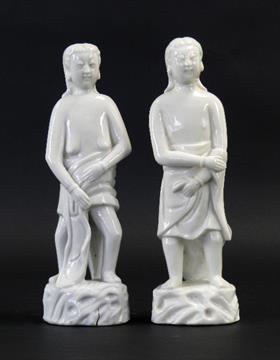
Kangxi Blanc de Chine Adam
Robert McPherson Antiques
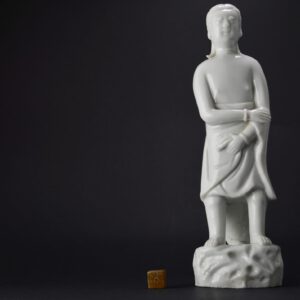
Provenance : Robert McPherson Antiques, The John Drew Collection of Chinese and Japanese Ceramics. John Drew was born in 1933 in Tideswell, Derbyshire, where his father was curate. The family moved to Norfolk whilst he was still a baby and his father became the rector of the parish of Intwood and Keswick. He was educated at Sedbergh School and after National Service in the R.A.F. being taught Russian, he went to Queens College, Oxford to read Greats (Classics). He spent nearly all his working life in various African countries as an archivist, moving to a post at Cape Town University in 1978. He remained in Cape Town after his retirement until his death in 2006. He had a great love of the English countryside (but not the climate) and this is shown in many of the pieces he collected. His taste was varied and ranged from Neolithic right through to the 18th Century. When we sent photograph to his home in Cape Town of pieces we thought he might be interested in, he would write long funny well observed letters back, wanting to add many of the items to his growing collection. Over the years we got to know him better and better, and during the last few years it was very rare for him to not want all the pieces we offered him. We knew his taste, even though his taste was so varied. This was in no small part because he had a very good eye and it was a pleasure finding things that interested him, because they were also very interesting to us. He never got to put his collection on display, something he hoped to do while on retirement in England, so it is with a mixture of pleasure and sadness that we offer these pieces from his collection. Each piece has a John Drew collection label, so when the collection is split up there will be some lasting record of the love and hard work he put into his two decades of collecting.
